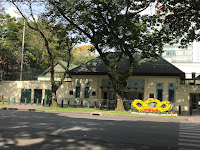This is an abbreviated version of my photo essay published in Vietnam magazine's February 2019 issue. All images are copyrighted.
During the Tet Lunar New Year, Nguyen Hue Boulevard Saigon River
One building that most represents the Communist government is the People’s Committee Building Ho Chi Minh City Saigon
during the war years knew it simply as “City Hall.”
Fifty years after the Tet Offensive, a modest U.S. Consulate (right) occupies the same land where the U.S. Embassy once stood, and where the Viet
Cong launched their shocking assault in 1968. The
haunting edifice (below) was left abandoned for years after the 1975 evacuation and then demolished in 1998. Perhaps
the last American Army general to visit the iconic helipad was Norman Schwarzkopf, a Vietnam War veteran who commanded U.S. forces during the Gulf War. As a CBS News analyst in 1993, he
stood on the rooftop with anchorman Dan Rather while filming a TV documentary.
Of the remaining BEQs (Bachelor Enlisted Quarters), the
Plaza Hotel (right) is one of the most peculiar. Boldly towering over Tran Hung Dao Street ,
the exterior is a botanical painting with ferns and leafy vines smothering all
nine stories. During the war, a typical room was occupied by three or four men,
except for the third floor, which was women-only. The top level was a popular
night club with rows of busy slot machines.
 |
| My room in 1969. |
The Plaza had several lucky
escapes: a rocket glanced off the roof, flooding a number of rooms; a terrorist
bomb was defused on Thanksgiving Day in 1969; and security guards fought off a
VC sapper attack in 1968. Today, the building is a dormitory for the University of Economics
A colorful past, plus a romantic roof garden, make the Rex Hotel a
legendary landmark in contemporary Ho
Chi Minh City . Previously an auto dealership, the Rex
provided housing for American officers, although some of the first guests were U.S. enlisted
men who arrived with an Army helicopter company in December 1961. According to
Jack Van Ommen, a supply clerk, “We had our delayed Thanksgiving turkey dinner
served from our field kitchen on the Rex roof top terrace.” The Rex was also
home to the original armed forces radio studios, as well as daily military
briefings that cynical reporters nicknamed the “Five o’clock Follies.” Today, the Follies is a specialty rum and
vodka cocktail served at the garden bar for more than $12.
 |
| The Continental today. |
 |
| The Continental in 1969. This is the cover photo for my blog. |
Tu Do Street, renamed Dong Khoi after the war, is no longer a place where you can find "Saigon Tea," typically a diluted tea that GIs were obligated to buy for a bar girl's companionship, but the commercial thoroughfare is still a trendy downtown destination. One of the last surviving GI bars was operating in 1988 as the Lan Thanh coffee shop (right), where customers could also order Vietnamese-made "33 Beer." The site is now a gift shop and travel agency, seen below in 2018.
Writer's footnote: In preparing for my photo assignment, I returned to Vietnam with the same 35mm film camera I have carried for nearly 50 years, an Asahi Pentax. I purchased it at the Cholon Post Exchange in Saigon for $120. I also had my Apple iPhone7, and used the phone camera for two of the photos published in this article.
* Vietnam magazine is typically available at Barnes and Noble.
* Vietnam magazine is typically available at Barnes and Noble.









